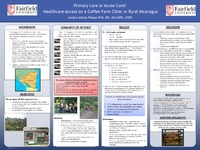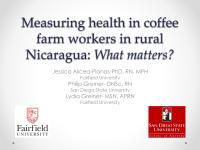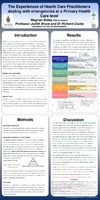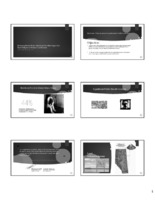| dc.contributor.author | Alicea-Planas, Jessica | en |
| dc.date.accessioned | 2016-03-17T12:50:06Z | |
| dc.date.available | 2016-03-17T12:50:06Z | |
| dc.date.issued | 2016-03-17 | |
| dc.identifier | INRC15PST33 | en |
| dc.identifier.uri | http://hdl.handle.net/10755/601594 | |
| dc.description | <p>Research Congress 2015 Theme: Question Locally, Engage Regionally, Apply Globally. Held at the Puerto Rico Convention Center.</p> | en |
| dc.description.abstract | <p>Session presented on Friday, July 24, 2015:</p>
<p><strong>Purpose:</strong> Nicaragua is a country with nearly 6 million inhabitants and is considered the second poorest country in Latina America. In Nicaragua rural areas contain 45 % of the country's population, yet 65% of the poor and 80% of the extreme poor live in these areas. Rural poverty is often more profound than urban poverty, with rural communities facing multiple challenges which may put them more at risk for negative health outcomes. Migrant workers, especially, are considered a marginalized population and may face an assortment of health challenges like infectious diseases, chemical and pesticide related illnesses, heat related illnesses, traumatic injuries, poor dietary options, respiratory conditions and mental illness (Hansen & Donohoe, 2003). People who live in rural areas, also have difficulties accessing an appropriate level of care due to inhospitable physical terrains, inadequate infrastructure on many roads and distance to closest medical facility. This purpose of this poster will be to describe the results of a chart review as part of a comprehensive healthcare needs assessment to examine the health and health education needs of agricultural (coffee farm) workers in rural Nicaragua and explore areas for future actions. Specific aims included probing the following questions: i. What are the reasons that people are accessing care at the onsite clinic for? ii. What are the most common diagnoses? iii. What services are available at the clinic and what are workers referred out to the nearest town for? iv. What types of treatments are available onsite at the clinic? What medication and/or treatments are most often prescribed? v. Are complementary and alteRNive forms of care used? If so, what are they and what are they used for?</p>
<p><strong>Methods:</strong> This study was reviewed by university IRB and granted exemption. The Santa Maura coffee farm is located in north central Nicaragua, roughly four hours north of Managua. There is an on-site clinic, with a nurse provider available 7 days a week. The clinic is open to both migrant and non-migrant workers of the farm and those in surrounding communities or near-by coffee farms as well. Over a period of three days in October 2014, a random review of medical visits was completed.</p>
<p><strong>Results:</strong> Over three days a total of 334 clinic visits (with dates between June 30 to October 4, 2014) were reviewed at the on-site. Ages of patients ranged from 9 months to 90 with 33% female and 67% male. Preliminary data analyses demonstrate that 190 of these visits were made by residents who lived on the farm where the clinic is located. The remaining visits were made by people either living in surrounding towns or near-by coffee farms. Only 10% of these patients were seen for chronic issues, which included hypertension, GERD, a pap result and birth control. 90% of the visits reviewed were for acute problems or conceRN 49 visits were for pain related problems, 32 visits related to trauma/work related injuries, 52 visits related to acute GI issues, 42 visits related to infections and 44 visits related to common cold/allergies.</p>
<p><strong>Conclusion:</strong> There is limited information available on the health of rural coffee farm workers in Nicaragua and this is information does fill a gap in the literature. This chart review was completed as the initial phase of a healthcare needs assessment of rural coffee farm workers in Nicaragua. The visits reviewed were during non-harvest times, limiting the number of migrants that would have accessed the services. Although the clinic nurse recognizes the importance and need for primary prevention and care, the clinic is primarily used for acute visits only. Limited resources may factor in to the reason behind not providing certain primary care options. The lack of visits for chronic care should not preclude the need. Previous data from a study completed on this farm demonstrate that nearly 60% of the men had blood pressures in the pre-hypertensive range and 21% of that sample was hypertensive (Alicea-Planas, Greiner & Greiner, under review). In light of the fact that the majority of these visits were for diagnoses that could have been prevented through health education, further exploration of the types of information available and accessible to this population is needed. Potential areas of investigation are occupational hazard training, hand-washing education, accessibility of medication and knowledge of primary prevention. Future research included conducting focus groups with both migrant and permanent workers on the farm, to further explore what they identify as their healthcare needs and target areas of health promotion.</p> | en |
| dc.format | Text-based Document | en |
| dc.language.iso | en | en |
| dc.subject | Nicaragua | en |
| dc.subject | Coffee Farm | en |
| dc.subject | Healthcare Access | en |
| dc.subject.mesh | Rural Health Services | en |
| dc.title | Primary care or acute care: Healthcare access on a coffee farm clinic in rural Nicaragua | en |
| dc.type | Poster | en |
| dc.rights.holder | <p>
All rights reserved by the author(s) and/or publisher(s) listed in this item record unless relinquished in whole or part by a rights notation or a Creative Commons License present in this item record.
</p><p>
All permission requests should be directed accordingly and not to the Sigma Repository.
</p><p>
All submitting authors or publishers have affirmed that when using material in their work where they do not own copyright, they have obtained permission of the copyright holder prior to submission and the rights holder has been acknowledged as necessary.
</p> | en |
| dc.description.note | <p>Items submitted to a conference/event were evaluated/peer-reviewed at the time of abstract submission to the event. No other peer-review was provided prior to submission to the Henderson Repository.</p> | en |
| dc.type.category | Full-text | en |
| dc.evidence.level | N/A | en |
| dc.research.approach | N/A | en |
| dc.subject.cinahl | Rural Health Services--Nicaragua | en |
| dc.subject.cinahl | Health Services Accessibility | en |
| dc.subject.cinahl | Health Services Accessibility--Nicaragua | en |
| dc.subject.cinahl | Nicaragua | en |
| dc.contributor.department | Non-member | en |
| dc.author.details | Jessica Alicea-Planas, RN-CHES | en |
| dc.conference.name | 26th international Nursing Research Congress | en |
| dc.conference.host | Sigma Theta Tau International | en |
| dc.conference.location | San Juan, Puerto Rico | en |
| dc.date.conferenceyear | 2015 | |
| dc.description.reviewtype | Abstract Review Only: Reviewed by Event Host | en |
| dc.description.acquisition | Proxy-submission | en |





